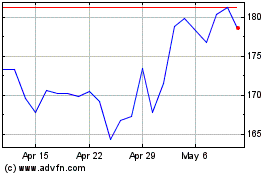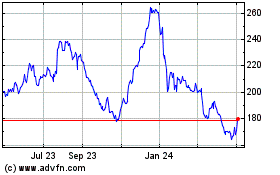U.S. Durable-Goods Orders Rebound, Jumping 4.4% in July
August 25 2016 - 9:20AM
Dow Jones News
WASHINGTON--Demand for long-lasting factory goods rebounded in
July, a sign the manufacturing sector could continue to stabilize
in the second half of the year.
New orders for durable goods--aircraft, industrial machinery and
other products designed to last at least three years- rose a
seasonally adjusted 4.4% in July from the prior month, the Commerce
Department said Thursday, the largest monthly jump since
October.
Economists surveyed by The Wall Street Journal had expected a
rise of 3.2%.
June's figures were revised to a 4.2% decline, from an earlier
estimate of a 3.9% decrease. Through the first seven months of the
year, durable goods orders were down 0.9%, compared to the same
period in 2015.
The data suggest the manufacturing sector is firming in the
second half of the year. The latest report reflects the first full
month of data since the United Kingdom voted to leave the European
Union in late June. After the vote, the dollar strengthened further
against the British pound and euro, but it has fallen again since
the end of July.
July's rise was led by more robust demand for transportation
equipment, orders of which rose 10.5%. That was driven by the
volatile category of civilian aircraft and parts, which showed an
89.9% increase in orders over the month. Separate data from Boeing
Co., the largest aerospace company in the U.S., showed 73 orders
for large jets in July, up from 12 in June.
Orders for durable goods excluding the transportation category
rose 1.5% from June, and orders excluding defense rose 3.8% last
month.
Data on durable-goods orders can be uneven from month to month
and are often revised.
A closely watched proxy for business investment, new orders for
nondefense capital goods excluding aircraft, rose for the second
straight month in July. They were up 1.6% from June, the largest
gain since January.
But orders in the category were still down 4.3% in the first
seven months of the year, compared with the same period in
2015.
Investment in capital goods, such as machine tools or robotics
equipment, is a key ingredient in boosting workers' wages and
productivity, as well as corporate profits. The lack of business
investment is a factor in the economy's sluggish growth and weak
productivity gains. Productivity, or output per hour worked, fell
for the third time in the second quarter, the longest streak of
falling productivity since 1979.
After steadily climbing in the first few years of the recovery,
manufacturing output has mostly flattened in the past two years. A
sharp drop in oil prices curbed new investment in the energy
sector, and a strengthening dollar made U.S.-made goods more
expensive for overseas buyers. Still, steady hiring and low
interest rates have stoked domestic appetite for some durable
items, such as cars, helping counter the lack of capital investment
and foreign demand.
But consumer demand can only go so far in spurring economic
growth. Federal Reserve officials, who gather with other central
bankers this week for an annual conference in Jackson Hole, Wyo.,
face the possibility the U.S. economy is stuck in a "new normal" of
low growth and productivity.
The durable orders report is sync with other recent reports
suggesting the U.S. manufacturing sector stabilized in July. A
Federal Reserve report showed manufacturing output posted its
largest monthly advance in a year in July. And the Institute for
Supply Management's gauge showed manufacturing activity expanding
in July for the fifth straight month.
Thursday's report showed orders for motor vehicles and parts
were flat in July. Demand for machinery rose 1.6%. Orders for
computers and electronic products posted their largest increase
since March 2015, up 3.6%.
Shipments of durable goods rose 0.2% during the month, but are
down 1.1% compared with shipments in the first seven months of last
year.
Write to Anna Louie Sussman at anna.sussman@wsj.com and Josh
Mitchell at joshua.mitchell@wsj.com
(END) Dow Jones Newswires
August 25, 2016 09:05 ET (13:05 GMT)
Copyright (c) 2016 Dow Jones & Company, Inc.
Boeing (NYSE:BA)
Historical Stock Chart
From Mar 2024 to Apr 2024

Boeing (NYSE:BA)
Historical Stock Chart
From Apr 2023 to Apr 2024
